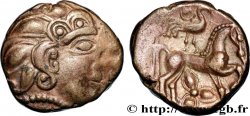bga_1011150 - GALLIEN - LEMOVICES (Region die Limoges) Statère à la grue
2 000.00 €
Menge
In den Warenkorb

Type : Statère à la grue
Datum: c. 100-50 BC.
Name der Münzstätte / Stadt : Limoges (87)
Metall : Elektrum
Durchmesser : 20 mm
Stempelstellung : 12 h.
Gewicht : 6,80 g.
Seltenheitsgrad : R2
Kommentare zum Erhaltungszustand:
Flan ovale et centré. Droit un peu brouillon, très joli revers bien complet. Patine de collection
N° im Nachschlagewerk :
Vorderseite
Titulatur der Vorderseite ANÉPIGRAPHE.
Beschreibung Vorderseite Tête à droite, la chevelure en grosses mèches aquitaniques.
Rückseite
Titulatur der Rückseite ANÉPIGRAPHE.
Beschreibung Rückseite Cheval à droite, une grue posée sur la croupe et un trèfle entre les jambes.
Kommentare
Cette variété correspond à la classe II de la série 1076 “à la grue et au trèfle” du Nouvel Atlas.
Le motif d‘accolade partant de la bouche, devant le visage, est parfois interprété comme le signe de la parole ; on retrouve ce détail sur les statères des Bituriges, mais aussi sous forme des deux dauphins, plus ou moins stylisés, sur la plupart des monnaies d’argent du sud, dites “à la croix”. On notera qu’au revers, le cheval a lui aussi une sorte de volute qui lui sort de la bouche.
This variety corresponds to class II of series 1076 “with the crane and the clover” of the New Atlas. The hug pattern starting from the mouth, in front of the face, is sometimes interpreted as the sign of speech; we find this detail on the staters of the Bituriges, but also in the form of the two dolphins, more or less stylized, on most of the silver coins of the south, known as “the cross”. Note that on the reverse, the horse also has a sort of volute coming out of its mouth.
Le motif d‘accolade partant de la bouche, devant le visage, est parfois interprété comme le signe de la parole ; on retrouve ce détail sur les statères des Bituriges, mais aussi sous forme des deux dauphins, plus ou moins stylisés, sur la plupart des monnaies d’argent du sud, dites “à la croix”. On notera qu’au revers, le cheval a lui aussi une sorte de volute qui lui sort de la bouche.
This variety corresponds to class II of series 1076 “with the crane and the clover” of the New Atlas. The hug pattern starting from the mouth, in front of the face, is sometimes interpreted as the sign of speech; we find this detail on the staters of the Bituriges, but also in the form of the two dolphins, more or less stylized, on most of the silver coins of the south, known as “the cross”. Note that on the reverse, the horse also has a sort of volute coming out of its mouth.








 Berichten über einen Fehler
Berichten über einen Fehler Die Seite drucken
Die Seite drucken Teilen meiner Auswahl
Teilen meiner Auswahl Stellen Sie eine Frage
Stellen Sie eine Frage Einlieferung/Verkauf
Einlieferung/Verkauf
 Details
Details










